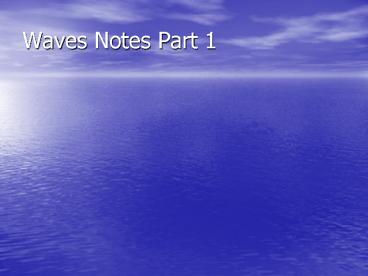Waves Notes Part 1 - PowerPoint PPT Presentation
1 / 22
Title:
Waves Notes Part 1
Description:
Waves Notes Part 1 Wave Disturbance that moves through matter or space. Carry/transfer energy from one place to another. 2 Main Types Electromagnetic Mechanical ... – PowerPoint PPT presentation
Number of Views:466
Avg rating:3.0/5.0
Title: Waves Notes Part 1
1
Waves Notes Part 1
2
Wave
- Disturbance that moves through matter or space.
- Carry/transfer energy from one place to another.
3
2 Main Types
- Electromagnetic
- Mechanical
4
Electromagnetic
- Waves that can travel through matter or empty
space where matter is not present. (also called a
vacuum) - Examples radio waves, microwaves, infrared rays,
visible light, ultraviolet (UV) rays, and x-rays
all travel as electromagnetic waves - General structure (transverse waves)
5
Mechanical
- Require the particles of the medium to vibrate in
order for energy to be transferred. - Sound waves, as with all mechanical waves, CANNOT
be transferred or transmitted through empty space - Examples Water waves, earthquake/seismic waves,
and sound waves - Structure transverse OR compressional
6
- Transverse Wave
- Waves which vibrate by moving back and forth and
perpendicular (at right angles) to the direction
the wave travels are called transverse waves.
Ex Secondary Waves, Electromagnetic waves - Electromagnetic are double transverse waves
because they are made of electric and magnetic
fields - Pick a single particle and watch its motion.
7
Compressional Waves
- Compressional waves are mechanical type waves
- Vibrate by pushing together and moving apart
parallel to the direction in which the wave
travels (Aka longitudinal) Ex Primary Waves
Sound waves - Pick a single particle and watch its motion.
- Particles move from left to right.
8
- Some waves are both transverse and compressional
- Water waves and surface waves (seismic ) are
examples of waves that involve a combination of
motions. - Look at the two particles in blue to show that
each particle travels in a clockwise circle as
the wave passes.
9
Transverse Waves
10
Properties of Waves
- A.) FREQUENCY
- Waves are measured in hertz.
- Measure of how many waves pass a point in a
certain amount of time - The higher the frequency Shorter wavelength,
greater energy carried
Higher Frequency Lower Frequency
11
- B.) AMPLITUDE
- Measures of the distance between the middle of a
wave and a crest or trough - For Light the greater amplitude the brighter the
light. - Sound greater amplitude the louder it is
- The Amplitude of a wave is related to the energy
which it transports.
Lower Amplitude
Greater Amplitude
12
Properties of Waves
- C.) WAVELENGTH
- Measure of distance from crest to crest or trough
to trough (transverse) - A higher frequency causes a shorter wavelength
and greater energy
13
Compressional
- Label rarefaction and compression
Rarefaction
Compression
14
Compressional
Transverse
15
Properties of Waves
- A.) WAVE SPEED
- The distance a wave travels in an amount of time
- Wave speed is determined by two things
- Type of wave
- Nature of the medium (material)
- Electromagnetic waves (including light) travel at
the same speed in empty space (vacuum) which is
(3 x 108 m/s) - Travel slowest in solids/liquids
- Travel fastest in air/gas
16
B.) Color Filters
- Write see color notes
17
- C.) REFLECTION
- When a surface (mirror or object) that doesnt
absorb or transmit light. - -(Bounces off)
- -Or sometimes the surface will absorb some light
and reflect the rest. Examples Banana-reflects
yellow absorbs all other colors, Leaf-reflects
green and absorbs all other colors. - Light waves reflected off a mirror
- Sound waves echoes (used by bats and dolphins
to communicate)
18
Reflection of Waves
19
- D. REFRACTION
- When light passes through a different medium and
bends because it is changing speeds. - Examples
- P-waves entering the Outer Core
- Rainbows formed as light travels through rain
drops - Pencil looking bent in water
- Light traveling through a prism
20
Refraction of Waves
DRAW THIS
21
- E. DIFFRACTION
- When light bends around an opening
- Examples
- Light waves bend under doors or through windows
- Sound waves bend through open doors and go down
hallways.
Brain Pop on Refraction and Diffraction
22
Diffraction of Light Waves































